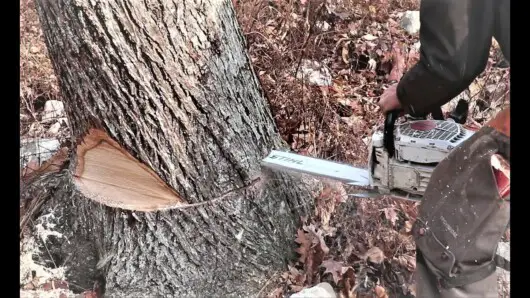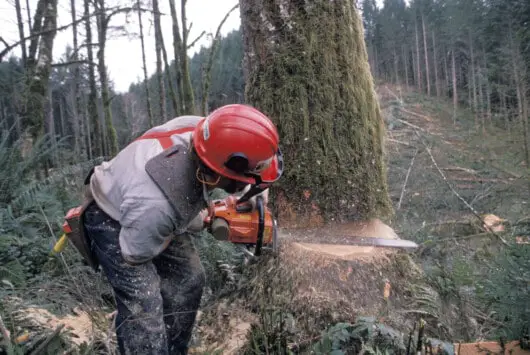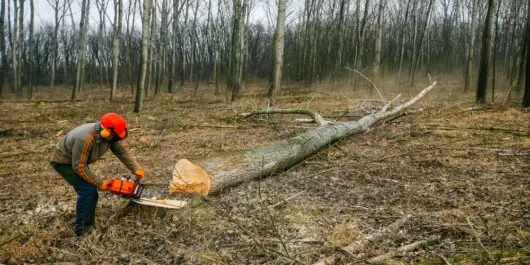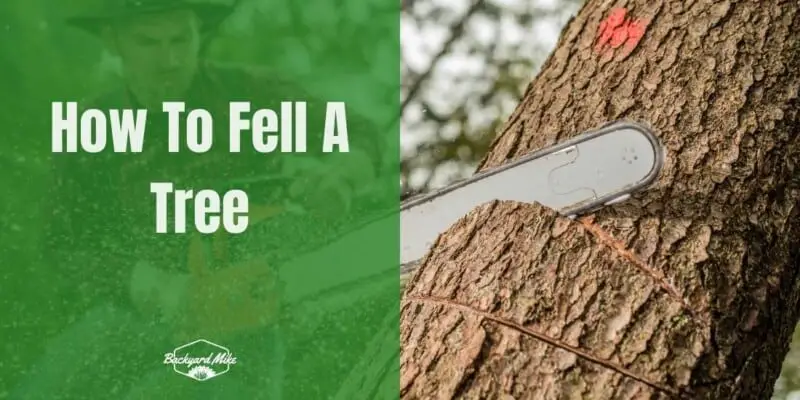Are you looking for an easy and straightforward guide on how to fell a tree? Felling a tree is an important skill to have, and understanding the basics of how to do it correctly is essential. This article will provide a step-by-step guide to help you fell a tree safely and successfully. So, read on if you want to learn the proper techniques and gain the confidence to take on this task.
Overview of felling a tree
Trees go a long way in making your property beautiful and adding value, but sometimes, trees may be unsafe and unhealthy and have to come down. Turning to tree removal professionals is certainly an option, but it is a costly option. The cost of removing a tree can range from a couple of hundred dollars to a couple of thousand dollars. With the right tools and the right technology, you can take down trees from your property safely and efficiently.

Felling a tree refers to the process of causing the tree to fall down by either cutting with a chainsaw or sawing with a handsaw. Felling a tree using a chainsaw takes planning and must be properly thought through. If you are a beginner, it’ll be a smart idea to have someone who is an experienced chainsaw user out there with you for help. Before felling the tree, you should ensure that you have all the necessary permits and/or permission. Some cities and areas have strict environmental regulations.
When you’re felling a tree, think of your safety first and prevent accidents. Notice where the tree is located and the objects around it. Houses, power lines, barns, fences, and other structures can get damaged due to trees or limbs falling. If there are roads located in the fall zone, you must set up warning signs. If you’re a beginner and there are objects near, you should get an experienced person to help with the felling.
Pay close attention to other trees, too. Felling a tree could have a domino effect on other trees that may be weakened by the tree rot and leaning. Even if you don’t think that the tree you intend to cut will strike an object, a tree hit by the tree you’re cutting may fall in an unexpected way. This is why you should imagine all possible scenarios before starting the process.
Safety precautions for felling a tree
Felling a tree can be a dangerous and challenging task that needs careful planning and execution. Before starting out, you’ll need to identify certain things like the type of tree, its position, the direction of fall, and more. Here are the precautions you’ll need to take –
#1. Identify the type of tree
It is essential that you identify the type of tree you are felling, as different species have different wood densities, strengths, and growth patterns. Some species like pine and spruce contain a lot of resin, which makes them more prone to kickback. Meanwhile, trees like oak and maple are harder and denser and will require more effort for cutting through. Before starting out, take the time to identify the tree species and research the specific characteristics that might impact the felling process.
#2. Analyzing the tree’s position
Once you have identified the species of the tree, it’ll be time to analyze its position. You should look out for any obstacles or hazards that may impact the felling process, like power lines, buildings, and other trees. You must take note of the tree’s lean and determine the way it is likely to fall naturally. Furthermore, you should keep in mind that a tree could shift or move unexpectedly, so it’ll be crucial to be aware of the surroundings and prepared to adapt your plan if needed.
#3. Determine the direction of the fall
After that, it will be time to determine the direction of the fall. For doing that, you will have to use a felling wedge and a chainsaw. You should determine the direction in which the tree is leaning. Felling the tree in the direction of the lean will be the easiest option. Any other felling direction will require ropes for pulling the tree against the lean. It can lead to a scenario where an expert call might be the best option.
You should also determine the path in which you’ll want the tree to fall. Your felling zone must be clear of other trees, structures, electrical lines, and other types of hazards. If you are felling a tree near a road or a populated area, you should consider cordoning off the area where the tree will be landing.
Further, you should also ensure that you have planned out an escape route. The route needs to be free of any hazards and debris and needs to be at a 45° angle from the fall path. This angle will allow you to easily avoid any part of the tree that might fly around as it breaks and falls.
Preparing to cut a tree
Felling a tree is a task that needs proper planning, the right tools, and protective gear. Whether you’re a professional or a casual homeowner looking to remove a tree, there are certain steps that you’ll have to take for getting the job done. With better preparation, you will be in a better situation to carry out this task properly.

Choosing the right tools
Before you start felling a tree, you’ll first need to choose the right tools. The tools that you will require will depend on the size of the tree and the location. At a minimum, you will require a chainsaw, a felling wedge, and a bow saw. If the tree is in a hard-to-reach area or particularly large, you might require additional equipment like a crane or a bucket truck. Further, you should also ensure that your tools are in proper working order, sharpened, and properly maintained before you start the job.
Marking the tree for cutting
Once you’ve got the right tools and equipment, the next step would be to mark the tree for cutting. This will involve identifying the area of the tree where you’ll want it to fall and marking it with chalk or spray paint. You should ensure that you’re choosing a location that is clear of any obstacles or hazards, such as power lines, buildings, or other trees. If you aren’t able to reach the tree, or it is particularly large, you might have to use a rope for guiding it to the ground.
Applying protective gear
It will be important that you wear the appropriate protective gear before you start felling a tree. This includes wearing a helmet, hearing protection, safety glasses, and gloves. You will also need to wear a face shield and a respirator if you are cutting down a tree that is diseased or infected with insects. You should also ensure that the protective gear fits you properly, and it is in a good condition to ensure maximum protection.
Furthermore, you must remember that felling a tree is dangerous. If you aren’t comfortable, you can also have a professional, do it. If you’re having a go at it yourself, you should ensure you’re wearing the necessary protective gear and undergo training. Make sure you use proper felling techniques and equipment and avoid taking shortcuts as it could jeopardize your safety and the safety of others.
How to fell a tree
Making the face cut
The open-faced notch will have a high degree of safety and uses an angle between 70 and 90 degrees. The face cut will start by making a single angled cut around 1/5th of the trunk for controlling the fall and marking the intended direction. This is helpful when you are felling trees on a flat or subtle-sloped terrain. Moreover, there are other benefits, like the notch remaining intact until the tree has hit the ground. This will leave you with a lesser chance of danger because of kickback.
For making a face cut, you should tilt the chainsaw and make a 60-degree angle cut in the downward direction. Further, remember to stop 1/5th of the way through the tree. After that, rotate the chainsaw horizontally or at an upward angle. Then, carefully cut inward until you meet the end of the first cut. You will be able to remove the wedge from the tree, which will leave a notch 1/5th of the way through the trunk.
Making a conventional notch cut
A traditional notch cut will work similarly to the open cut, but it has a smaller cutting angle. It is the most familiar type of cut for arborists, and the hinge will break around the 45-degree mark. This form of cut will be useful when you are cutting trees that are prone to splitting. This is because of the smaller angle as well as the break in the notch.
For making a traditional notch cut, you’ll need to tilt the chainsaw and make a 45-degree angle cut in the downward direction and stop 1/5th of the way through the tree. After that, rotate the chainsaw horizontally and cut inward carefully until you meet the end of the first cut. You’ll now be able to remove the wedge from the tree. You should be leaving the notch 1/5th of the way through the trunk.
Making a Humboldt notch cut
The Humboldt notch is a type of cut that reverses the angle of the cut. This has become a safe way of felling trees on uneven terrain or steep slopes. This happens as the angle is projected downward at a much higher degree. It’ll also work particularly well when felling thick trees.
For making a Humboldt notch cut, you should use your chainsaw and make a horizontal cut 1/5th of the depth in the tree. After that, make an upward 45-degree angle cut from below until you meet the end of the first cut. You can now remove the wedge from the tree. However, you should leave the notch 1/5th of the trunk at a downward angle.
Making the back cut
Once you have made the notch, you should move to the opposite side of the tree and make the back cut. This back cut will be referred to as the “felling cut” so you should remember that making this cut will result in the felling of the tree.
You should start the cut a bit higher than the apex of the notch. After that, you should cut toward the apex at a slight downward. This would prevent the tree free accidentally slipping or falling in the wrong direction.
You should continue until the tree starts falling or until you have reached around half-inch before the apex. Move out of the way as the tree falls. Your lookout person needs to alert you about falling branches and letting you know once the tree starts falling.
Clearing the area
Once you have cut the tree, and it has fallen down, you will need to clear the area of any wood, branches, and mulch. Also, clear away any obstacles that might be coming in the falling path. Remember that you have to have two escape routes opposite the direction the tree will likely fall. This way, you can move away when the tree is falling safely.
When the tree is falling, you will have to clear the area and reach a safe area until the tree falls. When you’re felling a tree, you will be safer if you have a trusted assistant standing a few feet behind you. Make sure you have someone watching the top of the tree for any falling branches and let you know where the tree starts falling. Have your partner tap you on the shoulder to alert you when it is time to vacate the area.
If it is early in the cut and your partner gives you the tap, you should leave the chainsaw and walk away immediately. It means that the branch is falling. Near the end of the cut, a tap will mean that the tree is beginning to descend.
Guiding the fall
When you’re felling a tree, make sure to make notches in a way that you can guide the fall properly. If the tree isn’t falling down on its own, you should tap in a felling wedge and get it moving before getting out of the way. In such situations, the metal felling wedges will be fine, since they’re able to hold up when they’re being hammered down into stubborn trees regularly. Aside from nudging the tree to move it, you could make use of polymer felling wedges. Use them to tap in behind the chainsaw bar for preventing the chainsaw from getting pinched in the trunk.
Cleaning up after the felling
Once you’re done felling a tree, the work isn’t complete. The next step would be to remove the tree and clear the area before disposing of the tree properly. Here is how you can do that –
Removing the tree from the area
Before you remove the tree from the area, it’ll be important that you cut it into smaller and more manageable pieces. Use a chainsaw or handsaw for cutting the trunk and branches into smaller sections that you can easily lift and transport. Once you have cut the tree into smaller pieces, you will need to remove it from the area. If the tree is small enough, you can move it manually. If it is a larger tree, you might have to use equipment such as a log splitter, tractor, or skid steer loader for removing it.
Disposing of the tree properly
There are multiple ways of disposing of a felled tree, and it will depend on your location and local regulations. A great option would be to bring the tree to a local landfill or composting facility. Another option would be to use the wood as mulch or firewood. You can also consider donating the wood to a local charity or community group that can be used for construction or firewood.
Another option would be to recycle the tree by turning it into wood chips, which you can use for mulch or as a fuel source. Many communities have recycling programs that pick and recycle the tree for you.
Once you have cleaned the area and disposed of the tree, you should consider planting a new tree in the spot where the old one used to be. This will not only help you replace the tree that was removed, but it’ll also provide environmental benefits like reducing erosion, improving air quality, and providing habitat for wildlife.

Safety tips to remember when felling trees
Felling trees with a chainsaw can be quite a dangerous task, and it’ll be important to prioritize safety above everything else. For your safety, you’ll need to consider certain safety tips. Here are the essential safety tips that you should keep in mind when felling trees with a chainsaw –
#1. Wear appropriate safety gear
Before you start your chainsaw work, it will be important that you put on the appropriate safety gear. This includes a helmet, safety glasses, steel-toed boots, hearing protection, gloves, and more. Moreover, it’ll be important that you wear protective chainsaw chaps to protect your body against chainsaw kickback.
#2. Choose the right chainsaw and equipment
Choose a chainsaw that is appropriate for the type and size of the tree you’ll be cutting. You should ensure that the chainsaw is well-maintained and it has a sharp chain. Further, it is also important that you have the necessary equipment like ropes and wedges for guiding the fall of the tree.
#3. Plan the felling operation
Assess the tree and the surrounding area before you start the cutting. Look out for potential hazards such as power lines, buildings, and other obstacles and plan the cut accordingly. You should ensure that there’s a clear path for the tree to fall, and use warning signs to alert others in the area of the felling operation.
#4. Follow proper cutting techniques
Use proper cutting techniques when felling a tree, including the correct notch and back-cut. Avoid standing in the path of the falling tree, and use ropes and wedges to guide the fall.
#5. Stay alert and aware
You should maintain your focus throughout the operation and stay aware of the surroundings. You should avoid any distractions such as talking on the phone or listening to music. Moreover, keep an eye out for the weather, as rain or wind can affect the direction of the fall.
#6. Keep others at a safe distance
You should ensure that all bystanders are at a safe distance from the felling operation. You should make use of warning signs and barricades to keep others away from the cutting area and ensure that no one enters the fall zone.
#7. Clean the area
Once the tree has fallen, you should ensure that you clear away all debris and dispose of the tree properly. This will help you prevent any accidental hazards or tripping while also keeping the area safe for others.
FAQs
What are the steps for felling a tree?
Felling a tree is a complex process and requires careful planning and execution. The steps for felling a tree include determining the direction for the tree to fall, preparing the area around the tree, making cuts in the trunk of the tree, and finally felling the tree. It is important to take all necessary safety precautions, such as wearing protective gear, and to make sure the area is cleared of people and objects before starting the process.
What equipment do I need for felling a tree?
When felling a tree, it is important to have the right tools and equipment. The necessary equipment includes a chainsaw, protective gear like gloves, a helmet, and safety glasses, wedges, a felling lever, a tree-felling bar, and a line level. It may also be helpful to have an axe, a saw, and a hammer.
What safety precautions should I take when felling a tree?
When felling a tree, it is important to take all necessary safety precautions. This includes wearing appropriate protective gear, such as gloves, helmet, and safety glasses. It is also important to make sure the area around the tree is clear of people and objects, and to ensure the tree will fall in the intended direction. It is also important to follow all safety guidelines and instructions provided by the manufacturer of the equipment used.


